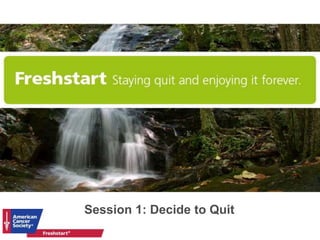This document outlines the objectives and content of Session 1 of a Freshstart Facilitator Training program. Session 1 focuses on introducing participants to the program, discussing nicotine addiction and health concerns of smoking. It covers behavior change models like the Health Belief Model and Stages of Change Model to help participants decide if they are ready to quit. Participants learn about managing ambivalence and identifying their key reasons for both continuing and quitting smoking. The session aims to help participants decide if they are committed to quitting smoking.












